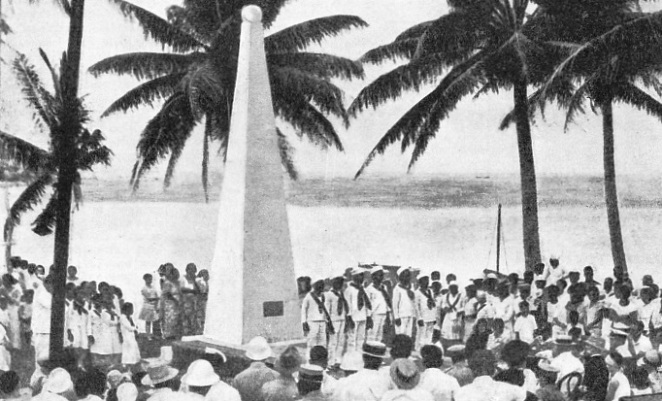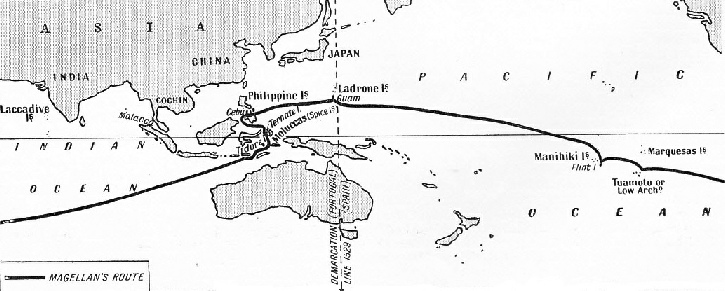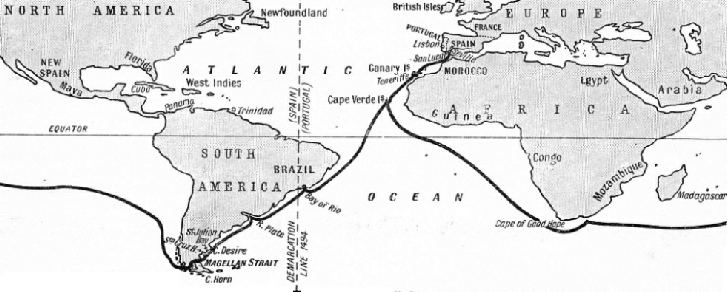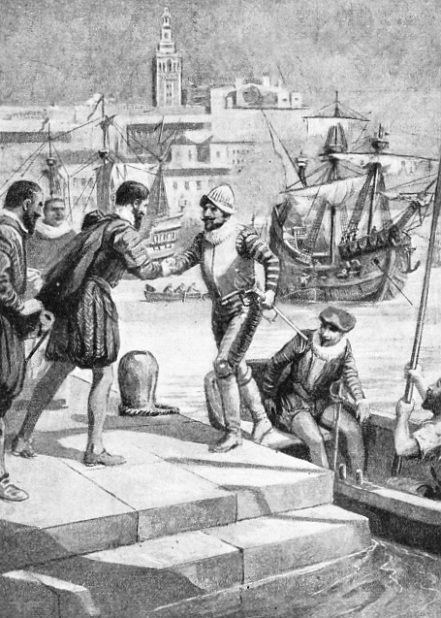

© Shipping Wonders of the World 2012-

The First Voyage Around the World
The adventures and misfortunes of the great sixteenth-
SUPREME FEATS OF NAVIGATION -

NINETY-
A KING’S meanness in refusing an increase in salary of a shilling a month to a man who had served him for some twenty years was one of the causes that led to the first voyage round the world. The monarch was King Manoel of Portugal, and the man Ferdinand Magellan. Magellan went in disgust to Spain, where he secured the backing and the ships that enabled him to discover the strait that bears his name. He was killed in the Philippines in an affray with the natives. Only a single vessel of his squadron completed the voyage of circumnavigation.
Born a Portuguese about 1480 and named Fernao de Magalhaes, Magellan changed his nationality and his name to the Spanish version, Hernando de Magallanes; in English, Ferdinand Magellan. Of noble birth, he became a royal page and received a court appointment, later obtaining leave to enlist as a seaman in the fleet that sailed from the Tagus for India under Francisco d’Almeida in 1505.
During his service in the East, Magellan showed qualities that gained him promotion to the rank of captain. Throughout his life he made only one friend, Francisco Serrano. Both were in a squadron which the Portuguese sent to Malacca, where they distinguished themselves during an attack by the Malays.
When Magellan returned to court his rank and his salary were raised, his emoluments being increased from 1,000 reis (then the equivalent of five shillings) a month to 1,850 reis (about 9s. 3d.). The appointment held certain perquisites, and the salary was in the nature of a token. Reserved and a “bad mixer”, he soon had enemies. His heart was in the sea, and during his stay at court he studied navigation and talked with the captains of ships who had made long voyages.
Magellan served against the Moors in Morocco, where he was wounded in the knee and permanently lamed. Unfit for active service, he was given the charge of cattle and horses taken from the Moors. He was accused of selling cattle to the Moors, and embarked for Lisbon without leave and sought an audience of the king, but was ordered back to Morocco. Later, armed with papers proving his innocence of the charges, he sought another audience, to ask for a salary increase of a shilling a month. On the king refusing, he asked permission to leave the court and be given employment in the navy. His request again refused, he asked permission to find employment elsewhere. The king contemptuously agreed, and when Magellan, whom the king had always disliked, bent to kiss his hand, he withdrew it, as an added mark of disfavour. Magellan limped out of the royal presence for the last time.
At a period when no man had sailed round the world its extent was still a matter of conjecture, and Magellan had theories which he proposed to put to the test by a voyage of circumnavigation. He had an acquaintance, Ruy Faleiro, who was an astronomer and a scholar skilled in the theory of navigation, although not a sailor. Magellan and Faleiro became partners, and by this pooling of practice and theory a scheme was evolved which was destined greatly to unsettle the world of that day. The Pope had divided the hemispheres between Spain and Portugal, awarding the western hemisphere to Spain and the eastern to Portugal. There had been bickering after the original allocation, and at the request of Portugal the line of demarcation had been shifted farther west. The eastern line of division was thus indefinite and the exact situation of the Moluccas or Spice Islands (in the Malay Archipelago) was not determined. They had been occupied by the Portuguese, but Magellan believed that they lay in the Spanish, and not the Portuguese, half of the world. He proposed to sail west, thus keeping in the Spanish hemisphere, find a strait which he believed existed, and so get across the barrier of South America. Then continuing west until he came to the Spice Islands, he proposed to take accurate observations to establish the longitude, and keep on sailing west to Spain.
Magellan set out for the Spanish court at Seville, and after initial difficulties secured the support of the king. He married the daughter of a Portuguese who had become a Spaniard and was of great assistance to him. The five ships selected for the voyage were the Santo Antonio (120 tons), Trinidad (110 tons), Concepcion (90 tons), Victoria (85 tons) and Santiago (75 tons). They were old vessels, and authentic details of them are not available. Magellan chose the Trinidad as flagship, and she was probably about 75 feet long, and 21 feet beam, with 10 feet depth of hold. There were about 275 souls in the five vessels at the outset; only eighteen came back in the Victoria, excluding four natives who had been impressed.
The Victoria alone made the round trip. The crews were cosmopolitan and included one Englishman, Master Andrew of Bristol, chief gunner of the Trinidad. Faleiro, Magellan’s partner, did not sail, having been superseded. The fitting out of the ships was hampered by intrigues, some of which were engineered by agents of the king of Portugal, whose hostility to Magellan continued. At last the five ships left Seville, sailed down the Guadalquivir to San Lucar, the port at the river mouth, and put to sea on September 20, 1519. At Tenerife, in the Canary Islands, stores, which had been sent out earlier, were taken aboard. While at the island Magellan received a letter from his father-

THE COURSE OF MAGELLAN’S EXPEDITION is shown on these maps. The five ships which began the voyage from Seville in 1519 were
the Santo Antonio (120 tons), Trinidad (110 tons), Concepcion (90 tons) Victoria (85 tons), and Santiago (75 tons). The Trinidad was Ferdinand Magellan’s flagship and was probably about 75 feet long by 21 feet beam, with 10 feet depth of hold. Out of the 275 men who had set out in the five ships only eighteen returned to Seville three years later, in the one remaining ship, the Victoria. Magellan was killed in the Philippines in 1521, when, at the head of forty-

A young Italian, Francisco Antonio Pigafetta, was one of the few survivors of the expedition, and his is t he best available account. Unfortunately for the seeker after facts, Pigafetta accepted as truth many things he heard, so that his account is a mixture of fact and fiction. He describes the crossing of the Equator, and the storms, during which they were comforted by the appearance at the masthead of the holy fire of St. Anselm.
There was trouble before the squadron reached the coast of Brazil. Magellan kept south of the usual course and, when the captains of the other vessels asked him why the course was not more westerly, he told them to follow the flagship and ask no questions. Captain Cartagena, at a meeting of the five captains, was insubordinate about the change of course and was promptly put in irons by Magellan; he was later reduced to seaman. The squadron anchored in the Bay of Rio on December 13, and had the luck to arrive with the rain, which the well-
Leaving Rio, the squadron encountered bad weather and ran into the River Plate for shelter. Magellan was not sure whether this might not be the strait leading to the South Sea and sent one vessel to explore. The captain, finding as he went on that the water became fresh and thus knowing he was in a river, turned back with the news. On went the squadron, hugging the coast and looking for the strait. Progress was slow; the coast was unknown and every bay had to be explored in search of an opening likely to be the strait. At the end of March, 1520, Magellan anchored in St. Julian Bay, in about latitude 49½ degrees South, to await fine weather.
The men were weary of the search and they were dismayed when put on short rations. The squadron was supposed to have been provisioned for two years, but, by mistake or fraud on the part of the contractors, only about half the stores had been supplied. The order curtailing the rations aroused a spirit of mutiny in three of the five ships. The smallest vessel, the Santiago, was not involved. Captain Quesada of the Concepcion was the ringleader and was supported by Captain Mendoza of the Victoria; the disrated Cartagena also was active. Captain Mesquita, of the Santo Antonio, who was Magellan’s cousin, was loyal, and when Magellan had invited his captains to dine with him aboard the Trinidad, Mesquita alone appeared. There was clearly something brewing, and Magellan prepared to deal with it.
I n the night the mutineers rowed to the Santo Antonio and captured the vessel and Mesquita, killing the mate. Quesada sent a boat to Magellan asking him to come aboard his vessel to discuss terms, which were that rations be restored to full allowance and that the ships should sail to Portugal. This second condition indicated that it was intended to deliver Magellan to the King of Portugal and to claim a reward for wrecking his voyage.
n the night the mutineers rowed to the Santo Antonio and captured the vessel and Mesquita, killing the mate. Quesada sent a boat to Magellan asking him to come aboard his vessel to discuss terms, which were that rations be restored to full allowance and that the ships should sail to Portugal. This second condition indicated that it was intended to deliver Magellan to the King of Portugal and to claim a reward for wrecking his voyage.
AT THE END OF THE VOYAGE. On September 6, 1522, the Victoria arrived at San Lucar with eighteen Europeans and four natives on board her, and on September 8 she anchored at Seville. Magellan was dead, but his object had been achieved. This illustration shows the survivors of the expedition being officially welcomed at Seville.
Magellan acted promptly. Having seized the boat and her crew, he sent a boat to the Victoria ordering Captain Mendoza to come aboard the Trinidad. Mendoza refused and was killed by Magellan’s messenger. A second boat sent under cover of the first attacked the mutineers in the Victoria and captured the ship. The Santiago, the Trinidad and the recaptured Victoria shifted to the mouth of the harbour, imprisoning the Santo Antonio and the Concepcion. Daring the night the Santo Antonio, having dragged her anchors and fouled the Trinidad, was boarded and captured. The following day saw the surrender of the Concepcion, the only vessel remaining in the hands of the mutineers.
Quesada was beheaded, and Cartagena was sentenced to be marooned. About forty men were sentenced to death, but sentence was remitted, and when the voyage was resumed they were released and returned to their duties.
A curious point about the mutiny is that at the same place, Port St. Julian, the second circumnavigator, Francis Drake, sentenced Doughty to be beheaded for mutiny.
Although Quesada had been executed a week after the squadron had reached the harbour, and the prompt action by Magellan had quelled the spirit of active revolt, hunger and cold weakened the spirit of his men and they petitioned him to return to Spain. Magellan said that only death would stop him and that rations could be augmented by catching fish and snaring birds. Still the men murmured, and a priest, Pero Sanchez de Reina, was arrested and sentenced to be marooned with Cartagena for inciting to mutiny.
The next event was the loss of the smallest vessel, the Santiago. Magellan had sent her out to explore the coast to the south, and she was blown ashore and wrecked. The crew were in a sorry plight on that desolate shore. They were saved by the courage of two men who reached Port St. Julian with the news of the accident, so that aid was sent to their shipmates. Late in August the four remaining vessels left harbour, Cartagena and the priest having been put ashore with some bread and wine and left to their fate.
Sailing south, Magellan intended to put in at the harbour of Santa Cruz, which had been found by the men of the Santiago. He was glad to reach the harbour, as the weather was bad He was about a degree farther south, however, and the days were lengthening. During the stay of six or seven weeks at Santa Cruz, the wreck of the Santiago was examined and all gear was recovered.
Towards the middle of October the real start was made, and the third day out they sighted a large cape and an inlet that might be the expected strait. Two ships sailed in to find out if it were a strait or a river, and Magellan waited for five days until the two vessels returned with the news that the water was salt. Then the passage began.
The two exploring vessels were commanded by Mesquita and by Juan Serrano, with whom Magellan had served in India. Juan is believed to have been the brother of Francisco Serrano, Magellan’s great friend. These two captains and the other officers of the squadron attended a meeting in the flagship some days after the squadron had entered the strait. Magellan said that they had undoubtedly found the strait, but because of the shortness of food, they could vote whether they should go on or return to Spain with the news. Every officer except Gomez, pilot of the Santo Antonio, voted for continuing, and Magellan turned to Gomez and said they would go on even if it came to eating the leather of the yards.
The search for the right passage through the strait was then resumed, and it was a wearisome search in that desolate maze. Two ships were sent to search the channels leading south, and Magellan’s ship and the Victoria reached a river which they called the Sardine River. Here they anchored while boats went on ahead. The boats returned with the news that they had reached the sea, but that, of the two ships sent south, the Santo Antonio, commanded by Mesquita, was missing.
It was discovered that Gomez, the pilot who had voted for turning back, had overpowered Mesquita, that a new captain had been chosen, and that the ship, piloted by Gomez, had reached the Atlantic and sailed for Spain. The whole crew told the story that they had sailed to the rendezvous, failed to find the flagship, and returned home, having deposed Captain Mesquita and put him in irons because he had tried to stab the pilot Gomez. The Spanish authorities were not satisfied, and put the principals, including the unfortunate Mesquita, into prison. When the little Victoria returned from her voyage Mesquita was released and honoured.
Thus the squadron of four ships which had entered the strait on the Atlantic side passed into the South Sea on November 28 only three ships strong, after a passage that had taken thirty-
Magellan’s statement that he would carry on even if they had to eat the leather of the yards came true, for Pigafetta says: “We also ate the oxhides which were nailed under the mainyard so that the yard should not scrape the rigging; they were very hard on account of the sun, rain and wind, and we left them for four or five days in the sea, and then we put them a little on the embers, and so ate them.” They also ate sawdust and rats. The drinking water was yellow.
This passage across the mightiest of the oceans was so terrible that Pigafetta said with justice: “I think that never man will undertake to perform such a voyage.” Those who at last followed in the wake of Magellan took care to be better provided. When Magellan’s vessels emerged from the strait they encountered a westerly wind which kept them close to the shore on the port tack for some days. Magellan must have been relieved when the wind became free, enabling them to set a course north-
On January 24, 1521, a small island was sighted, which is believed to have been one of the Tuamotu or Low Archipelago. They found birds and trees, but no water or fruit, and sailed on to what is believed to have been Flint Island in the Manihiki group. Finding nothing here, too, they called the islands the Unfortunate Islands.
At Guam, largest of the Ladrone Islands,which Magellan reached ninety-
These islanders were so ignorant that they could not understand bows and arrows. Food having been secured, the ships sailed to the Philippines.
The Leader's Death
Efforts were made to persuade the people to become Christians. The chief of Cebu was baptized and had an opportunity of becoming paramount with the aid of the white men, but a smaller chief refused to pay tribute to him. Magellan, determined to punish the recalcitrant chief, set out in personal command, despite the entreaties of his subordinates, and refused the aid of thirty war canoes manned by 1,000 natives.
With only three boats and forty-
The men, against the orders of Magellan, opened fire at long range, and their muskets were ineffective. Magellan, already lame in his left leg, was now wounded in the right by an arrow, and gave the order to retreat. He was overwhelmed and killed.
The chief of Cebu now plotted to murder the Spaniards, Magellan’s slave Enrique, who was to be freed under his master’s will, joining in the conspiracy. Serrano and other officers were killed, but the three vessels escaped with Captain Carvalho as captain-
In November, 1521, the two vessels reached Tidore, in the Moluccas, but before this Espinosa had replaced Carvalho as captain-
The little Victoria sailed with forty-
On September 6, 1522, the Victoria limped into San Lucar, and on September 8 she was anchored at Seville. Aboard her were eighteen Europeans and four natives of Tidore. The white men were the first to sail round the world.

CAPE PILLAR, at the western entrance to the Strait of Magellan. When the intrepid seaman had passed this point, originally called the Cape of Desire, he faced an ocean that he named Pacific, because, beyond the strait, fair weather set in. The crossing of the Pacific to the Ladrone Islands entailed great suffering because of lack of supplies.
You can read more on “Instruments of Navigation”, “Supreme Feats of Navigation” and
“The Voyages of Captain Cook” on this website.